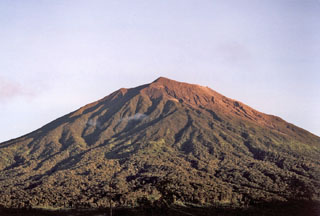Report on Kerinci (Indonesia) — 15 February-21 February 2023
Smithsonian Institution / US Geological Survey
Weekly Volcanic Activity Report, 15 February-21 February 2023
Managing Editor: Sally Sennert.
Please cite this report as:
Global Volcanism Program, 2023. Report on Kerinci (Indonesia) (Sennert, S, ed.). Weekly Volcanic Activity Report, 15 February-21 February 2023. Smithsonian Institution and US Geological Survey.
Kerinci
Indonesia
1.697°S, 101.264°E; summit elev. 3800 m
All times are local (unless otherwise noted)
PVMBG reported that the eruption at Kerinci was ongoing during 15-20 February. Ash plumes of variable densities were visible during 15-16 and 18 February rising as high as 250 m above the summit and drifting mainly NE, E, and W. White steam-and-gas plumes were visible on the other days. At 1207 on 15 February a dense brown ash plume rose 200 m and drifted E. At 0908 on 16 February a dense brown ash plume rose 250 m and drifted E, and at 1937 a gray-to-brown ash plume rose 150 m that drifted E and SE. The Alert Level remained at 2 (on a scale of 1-4) and the public was reminded to stay 3 km away from the crater.
Geological Summary. Gunung Kerinci in central Sumatra forms Indonesia's highest volcano and is one of the most active in Sumatra. It is capped by an unvegetated young summit cone that was constructed NE of an older crater remnant. There is a deep 600-m-wide summit crater often partially filled by a small crater lake that lies on the NE crater floor, opposite the SW-rim summit. The massive 13 x 25 km wide volcano towers 2400-3300 m above surrounding plains and is elongated in a N-S direction. Frequently active, Kerinci has been the source of numerous moderate explosive eruptions since its first recorded eruption in 1838.
Source: Pusat Vulkanologi dan Mitigasi Bencana Geologi (PVMBG, also known as CVGHM)

